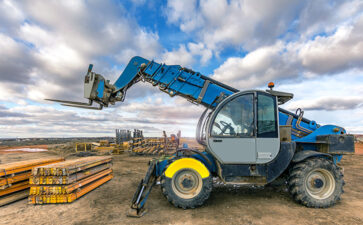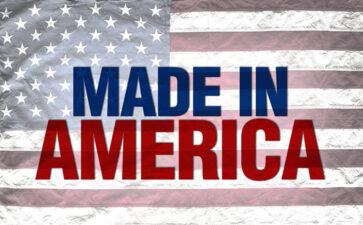Fueling Construction Success with Reliable Tire Flatproofing Technology
As the demand for residential housing and continued urban commercial development increases in the U.S., the domestic construction and building industry is expected to see further growth in the years ahead. By 2027, the overall market, including both building sectors (residential and non-residential), is forecast to reach $2.24 trillion in U.S. dollars—creating a sustained need for additional expansion within the supporting ancillary industries (raw materials, utility, infrastructure growth, and transportation) that are pivotal to supporting the marketplace. While there are anticipated caveats to this projected increase in construction spending—among them, the potential for higher materials costs due to recent tariff announcements, uncertain labor and workforce availability challenges, and potential supply chain roadblocks—the outlook is generally positive at present.
And as the construction industry appears bullish, project managers continue to seek ways to augment their operations and maximize fiscal solvency for greater workplace efficiency. One of the most essential items on the balance sheet involves the assurance—and availability— of proper and affordable materials and goods transportation. A busy construction work site is only as successful as its ability to adhere to both its designated development timeline—and prudent use of resources, with transportation being key among these. So called “workhorse” Off-the-Road (OTR) vehicles—such as excavators, forklifts, bulldozers, excavators and telehandlers—are the backbone of the job. Project administrators must be able to rely on these vehicles and other crucial equipment, and trust that they are working efficiently to deliver supplies in a dependable manner.
Oftentimes, the most cost-effective pathway for a site operations team is to utilize leased OTR vehicles and equipment to meet their core transportation requirements, versus purchasing wholly owned transport machinery. Why is this? Because diverse and upscale projects often need specialized equipment—but only for a portion of the construction build. Being able to tap temporary leased gear through a trusted equipment rental partner is simply more cost-advantageous and reduces the need for significantly higher upfront expenditures.
Additional bonus factors of working with a rental equipment provider include the following:
- Access to the latest, most advanced equipment;
- Simplified support with vehicle and equipment delivery and pick-up;
- Reduced maintenance fees;
- Assistance with debris and waste removal; and
- Elimination of potentially costly vehicle storage and broader insurance fees that would otherwise need to be absorbed directly by the equipment owner.
It is for these common-sense reasons that, as the construction industry grows, more and more developers are turning to rental equipment options. The fact that the rental market is robust and continuing to grow also bodes well for the entire OTR transportation sector—as project operators look to make smarter, more strategic decisions in connection with their supply handling and transport requirements.
But making the strategic decision to potentially rent vs. purchase OTR vehicles and gear is only one part of the equation. Another key area involves making project oversight choices with strong built-in ROI and a positive cost/benefit ratio. As the construction sector grows, how operators manage their transportation fleet is as important as the fleet itself. In addition to the price of the overall equipment, decisions about tire care, fuel management, and environmental and emissions reduction compliance become equally critical to balancing the books on a well-run job site. This is where polyurethane tire fill flatproofing technology comes into play.
Tire—or “foam” fill—technology offers a cost-effective, viable alternative to using traditional solid aperture or air-filled pneumatic tires. Choosing an effective flatproofing option can become a game-changing element of proper transportation management for decades to come. Plus, the cost-advantage and operational benefits of using tire fill flatproofing solutions apply equally to fully owned transport equipment and rental equipment—and administrators of both solutions can directly impact their bottom-line in a positive way by opting for tire fill flatproofing solutions to eliminate unexpected OTR tire flats.
Carlisle TyrFil, the pioneer in the category, offers TyrFil flatproofing which is pumped through the valve stem of pneumatic tires, replacing all the air. It cures into a durable, elastomer core within 24 to 36 hours, providing a flatproof solution that eliminates unexpected flats or blowouts on heavy equipment. OTR equipment with filled tires can safely operate over typical jobsite debris (such as nails, glass, sharp rocks, rebar and more) that can render vehicles useless until repair crews arrive—which, in turn, can halt production and reduce effective manpower utilization.
Additionally, tire fill technology decreases the uncomfortable jolting, bumpy impact within the central cab that may result from OTR equipment riding on solid aperture tires—a phenomenon in the industry known as “Solid Shock.” This jarring ride occurs from G-force pressure and cross-axle vibrations when the tires meet the rocky ground or roadway, but they can cause grave discomfort for drivers who spend hours behind the wheel and also render premature damage to an OTR vehicle’s chassis and supporting structure. Use of tire fill effectively eliminates Solid Shock, while also stopping flats and punctures in the field. A win-win for the labor force—and for operations teams.
The benefits of tire fill use also extend to the rental equipment outfits, who in turn lower their own costs. The elimination of flats prevents fiscal drain, ensures that customers and fleet renters are more satisfied and happier with their rental products, reduces necessary repairs and costs associated with maintenance crews and supplies, and ensures a more desirable overall rental outcome and customer experience across the board. Not to mention that access to a smoother ride extends the lifecycle of the potentially large fleet of highly expensive rental vehicles in their inventory by reducing unnecessary premature wear-and-tear to equipment inventory. Moreover, use of foam fill technology enables equipment rental outfits and renters to tailor the durometer or thickness of the foam filled tire to meet specific customized specifications related to the equipment—applications that reduce risk of worker injury and complete job requirements in a more streamlined fashion.
There is reason why TyrFil Flatproofing literally “Keeps the World Rolling.” And it’s much more than a brand slogan. Foam fill technology has revolutionized OTR tire performance for nearly six decades—saving operators and rental outfits time and money. Learn more today about the many ways that Carlisle TyrFil can augment rental equipment provider profits and benefit the construction sector in immeasurable ways. Visit us today at www.CarlisleTyrFil.com.


